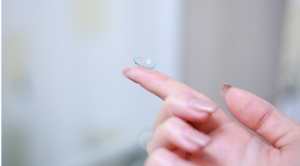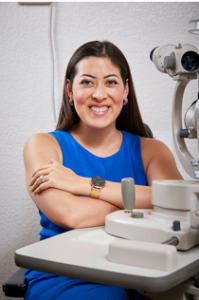Dr. Stephanie Woo on What to Know About Scleral Lenses
If you’re living with keratoconus, you may be relieved to learn that there are several treatments available. Options include contact lenses, Intacs, cross-linking, or in some advanced cases, a corneal transplant. If keratoconus remains untreated, it can continue to progress, resulting in worsening vision and constant changes to prescription lenses.

For many people, contact lenses are the first choice of treatment to help improve vision. But, if their keratoconus continues to progress, they may need to undergo cross-linking to slow or halt the progression. Cross-linking, however, is not intended to improve vision, which is why many people will still wear contact lenses after the procedure.
For those living with keratoconus who are interested in trying contact lenses to improve blurry or distorted vision, there are various options available. Types of lenses include soft contact lenses or Rigid Gas Permeable (RGP) contact lenses. Scleral lenses are a type of RGP contact lens that people with keratoconus often consider and eventually choose as the right option to suit their needs. These lenses, which are made of durable plastic that can transmit oxygen, are larger in diameter than other RGPs and are designed to cover the entire cornea, plus a portion of the sclera, the white of the eye.

To learn more about why scleral lenses are an appropriate vision management option for people living with keratoconus, we recently spoke with Dr. Stephanie Woo, O.D., F.A.A.O., F.S.L.S., of the Contact Lens Institute of Nevada. Keep reading for Dr. Woo’s thoughts on scleral lenses, including how often these lenses will last, what the benefits are, what sets them apart from other lenses, and more.
Why are scleral lenses an appropriate vision management option for people living with keratoconus?
Scleral lenses are a fantastic option for managing vision in patients with keratoconus. Because the shape of the eye steepens and becomes irregular over time, the image displayed on the retina (the back of the eye) is distorted, resulting in blurry, distorted vision. Sometimes patients experience other visual disturbances such as double vision, ghosted vision, problems with glare, and problems with night driving. The good news is that specialty contact lenses such as scleral lenses can help reshape the incoming image, so that the vision is much clearer and less distorted. Scleral lenses are made from gas permeable lens material. The lens is then filled with non-preserved saline, and then applied to the eye. The scleral lens helps to reshape the image that your eye takes in, resulting in a large improvement in your visual quality[1] while the lenses are on. Scleral lenses are comfortable, and they have given doctors the ability to fit even the most extreme forms of keratoconus.
What makes scleral lenses different from other available lenses, including RGPs or soft contact lenses?
Scleral lenses are much different than corneal gas permeable lenses and soft lenses. Most soft contact lenses do not have the capability to reshape the tear layer on the front surface of the eye, in which gas permeable and scleral lenses do.
Scleral lenses are much larger than other forms of contact lenses. The large shape means that the lens is able to vault over the cornea, which makes the fitting process easy in many cases. The edges of the scleral lens are tucked under the upper and lower eyelids, for comfort[2]. They also do not pop out of the eye, which is sometimes an issue with patients who wear gas permeable lenses. Scleral lenses are usually more comfortable than other types of contact lenses, which is why so many patients prefer them over other traditional options.[3][4]
How often do people need to get fitted for scleral lenses? How long do the lenses last?
Scleral lens patients should follow the advice of their eye doctor’s recommended follow-up schedule. Many keratoconus patients will only need to see their eye doctor once per year to check the fit and eye health. Other patients will need to see their eye doctors on a more frequent basis, such as every 3-6 months. This will all depend on your unique eye and the doctor’s treatment protocol.
Scleral lenses will generally last 1-3 years, however it is always recommended to follow up with your eye doctor at least once per year. This is to not only check the fit of the scleral lens and the condition of the lenses, but also to evaluate your entire ocular health. The life of the lens will also depend on how well you take care of the lenses, and how quickly the lenses may get scratched/damaged from normal wear.
Keratoconus patients may need to visit their doctor more frequently than other patients, because keratoconus is a progressive disease. This means that the shape of the cornea can change shape over time, which could alter the fit of the contact lens. This needs to be addressed right away, or else corneal scarring, epithelial defects, and other complications could arise. Even if patients are seeing well and comfortable in their lenses, keratoconus may be continuing to progress, so regular exams are important. Always follow the recommendations of your eye doctor – they know the best follow-up schedule for your unique situation.
Do scleral lenses slow the progression of keratoconus?
No, there is no research showing that scleral lenses or any type of contact lens slows down the progression of keratoconus. Therefore, patients who are successfully fit with scleral lenses may still need cross-linking. If keratoconus progression is left untreated, formerly well-fitting scleral lenses may no longer help you to see.
Do people who have been treated with cross-linking need to wear scleral lenses?
Patients are often confused on if they will have to wear contacts or glasses after cross-linking. It is important to remember that cross-linking slows down the progression of keratoconus, but it does not improve vision or revert the cornea to its original shape. It is very likely that patients will need to wear specialty contact lenses, such as scleral lenses, after they’ve had cross-linking. After the cornea has healed from cross-linking, your eye doctor will be able to refit you into a new contact lens, such as a scleral lens, which can help improve your vision. Most patients who undergo cross-linking will still need to wear a specialty contact lens to see well.
Stay tuned for more information from Dr. Woo on how to take care of your scleral lenses. To learn more about keratoconus, visit our website and follow Living with KC on Twitter, Facebook, and Instagram!
References
[1] Segal O, Barkana Y, Hourovitz D, Behrman S, Kamun Y, Avni I, Zadok D. Scleral contact lenses may help where other modalities fail. Cornea. 2003 May;22(4):308-10.
[2] Levit A, Benwell M, Evans BJW. Randomised controlled trial of corneal vs. scleral rigid gas permeable contact lenses for keratoconus and other ectatic corneal disorders. Cont Lens Anterior Eye. 2020 Jan 7:S1367-0484(19)30268-1.
[3] Levit A, Benwell M, Evans BJW. Randomised controlled trial of corneal vs. scleral rigid gas permeable contact lenses for keratoconus and other ectatic corneal disorders. Cont Lens Anterior Eye. 2020 Jan 7:S1367-0484(19)30268-1.
[4] Kreps EO, Pesudovs K, Claerhout I, Koppen C. Mini-Scleral Lenses Improve Vision-Related Quality of Life in Keratoconus. Cornea. 2020 Sep 16.